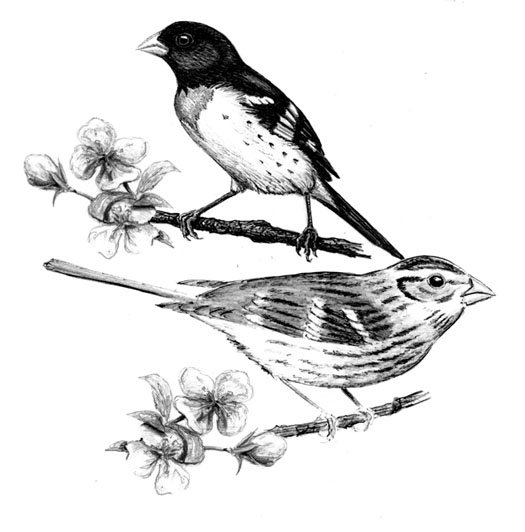
Dear Bird Folks,
Are these birds (see photo) common around here? This is the first time I have seen one.
– Carol, Harwich Port, MA
It’s time to fill your feeder, Carol,
I really like it when people send me photos. It makes bird identification so much easier. However, there’s a downside if you send me a photo of a bird on your feeder. I can become rather judgmental (like when I check out my neighbor’s new car to see if it’s something really cool or just another boring SUV). Instead of only looking at the bird, I sometimes focus on the feeder as well. I try to determine what kind of feeder you are using, and where it may have been purchased. In your case, you passed both criteria. You have a very good feeder and I have a feeling I know where it came from. But here’s the thing: the feeder was empty. If you read the instructions, it clearly says that this particular feeder works best when there is food in it. Oh, I’m just teasing. Besides, you don’t need to take advice from me. You have a beautiful Rose-breasted Grosbeak in your backyard and I don’t. That will show you what I know.
No, to answer your question, Rose-breasted Grosbeaks aren’t common around here. While the rest of Massachusetts seems to have a decent breeding population of grosbeaks, Cape Cod isn’t so lucky. I’m not sure if they’re avoiding us due to the habitat or because one bonehead in Mashpee who couldn’t even buy an ice cream cone without causing a stink. Whatever the reason, only a handful of these distinctive birds nest here each summer. The rest of the grosbeaks we see are migrants. And based on the number of calls I’ve received lately, this has been a good year to see these travelers. Even one of my lucky neighbors has had one in his yard, but I’m not jealous. I’ve seen the car he drives.
It’s hard to imagine a more distinctive bird than a male Rose-breasted Grosbeak. He has a jet-black head and body, white wing patches, a ginormous parrot-like beak and a bright-white belly. But it’s his “rose breast” that gives this bird its name. Actually, the whole breast isn’t rose, but there is an irregular blood-red patch just under the throat, making the bird look as if it was injured in a knife fight (probably while trying to sell ice cream in Mashpee). Even non-birders immediately know a male Rose-breasted Grosbeak when they see one. Yet, the same thing cannot be said about the females. They are brown and dull, and actually don’t even look like the same species. This is one of those instances where the male has gotten all the good looks, while the female has come up short (just like me and my…hmm. Nope. I was going to say something about my wife, but wisely changed my mind, just in case she decided to read this for a change).
It’s interesting how nature works. In many birds (Blue Jays and chickadees), both sexes look the same, but apparently they can still tell which is which, even if we can’t. The male and female of other species (cardinals and orioles) don’t look identical, but we can easily see the similarities. This is not the case with Rose-breasted Grosbeaks. The colorful male is dressed like a circus performer, while the chunky brown female looks like she should be loading trucks for UPS…yet somehow it all works out.
As I mentioned earlier, grosbeaks have really large beaks. With such serious beakage, large seeds – such as sunflower and even super-hard safflower – are no problem for them to crack open. Their love of these seeds makes grosbeaks regular visitors to backyard bird feeders, especially feeders that aren’t empty (ahem). In addition, grosbeaks eat an amazing number of insects, which surprises me. Most insect-eating birds (warblers, flycatchers, etc.) have rather thin, agile beaks, not big chunkers. And while many of the thinner-billed birds must beat large insects on a branch before they can be consumed, grosbeaks have no such problem. With a couple of quick crunches with that super-sized beak, down the hatch goes the insect. I think the bugs prefer the grosbeak method. Yes, they get eaten either way, but at least grosbeaks spare them a beating.
When they aren’t eating at a feeder, male Rose-breasted Grosbeaks, even as showy as they are, can be fairly difficult to find. Most of their time is spent up in the tree canopies, where they seem to disappear. Well, they disappear from view, but you’ll still know they’re around. Male Rose-breasted Grosbeaks are noted for their loud and beautiful vocal skills. What do they sound like? They sound somewhat like the American Robin. Some writers suggest that grosbeaks sing like robins that are “in a good mood.” At first, I felt their interpretation was pretty lame, but the more I thought about it, it made sense. Robins do indeed sing a lot, but they always seem slightly grumpy…perhaps from eating too many worms.
In your question, Carol, you indicated that this was the first Rose-breasted Grosbeak you have seen and if that’s the case, congrats on seeing a life bird. With some birds, such as loons or Snowy Owls for example, we tend to remember our first-ever sighting. The first grosbeak I saw was singing from an apple tree in my grandmother’s yard. I can still picture it. It was a beautiful male. However, the female wasn’t around. She must have been off somewhere else, probably loading trucks for UPS.